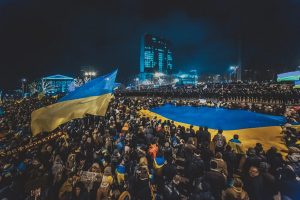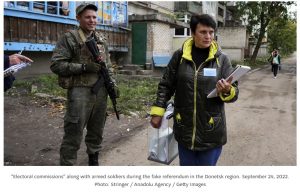Russia is staging pseudo-referendums in parts of the Donetsk, Luhansk, Kherson, and Zaporizhzhia regions to seize those territories illegally. Not Ukraine nor the international community will ever recognize their results. But that is still a dangerous development of events that should be widely condemned. Write in her article Veronika Lutska.

People protested for Ukraine’s territorial integrity in Donetsk, before Russian troops brought Russian “world” to the region.
March 5, 2014. Photo: Anton Skyba
The fake expression of people’s will in the temporarily occupied territories of Ukraine was announced for September 23-27. And even though the voting ballots had already been prepared beforehand, Russia forced people to participate in creating an image for propaganda. People are stopped in the streets and visited at home or a workplace.
How are the pseudo-referendums held?
Serhii Haidai, Head of the Luhansk Regional Military Administration, reported that people are told to fill the “ballots” in their apartments’ kitchens or yards. Members of the so-called “electoral commissions” were accompanied by armed people – and took notes if someone put their vote on “no”.

In the city of Starobilsk, the Luhansk region, occupants banned residents from leaving the city on the dates of a pseudo-referendum. And in Mariupol, people were forced to vote under the threat of losing their job, said Petro Andriushchenko, Advisor to the Mayor of Mariupol.
In the city of Enerhodar, the Zaporizhzhia region, armed Russian soldiers make door-to-door visits to get more people to vote in fake referendums, Dmytro Orlov, Mayor of Enerhodar, reports. And in Melitopol, citizens were forced to vote for their family members and neighbours, who had already left the city, said Mayor Ivan Fedorov.
In addition to fake referendums, Russian passports are also issued in the temporarily occupied parts of Ukraine. In many cases, people are left with no options: they are forced to accept Russian citizenship because occupants have blocked Ukrainian humanitarian aid and social allowance. This provides Russia with verified personal data of residents needed for staging a referendum.
And that is only a glimpse of how the Russian pseudo-referendums are held. They have nothing to do with the expression of the will of the Ukrainian people. And after all the horror of Russian occupation the world has seen in Bucha or Izium, it is impossible to believe they do.
Thus, many Ukrainians find another way to express their will. In many cities, Kherson in particular, people gather to protest against the occupation: peaceful civilians in front of armed Russian soldiers. Even in a state of terror created by Russian forces, acts of civil disobedience and partisan sabotage are still happening in the temporarily occupied territories.
Why does Russia need those referendums?
Russia is using pseudo-referendums as a vain attempt to legitimize its claims to the temporarily occupied territories. This tactic is not new: in 2014, a “referendum on the status of Crimea” took place under the control of many armed Russian soldiers. Illegal referendums “on separation from Ukraine” were also held in parts of the Donetsk and Luhansk regions.

More fake referendums have been in preparation since spring 2022, but they were constantly postponed. Now Russia is putting those plans into action after Ukraine conducted a successful counter-offensive and liberated most of the Kharkiv region, where the referendum was also initially planned.
The situation does not look good for Russia: the full-scale war is already lasting for seven months instead of 15 days, more than 50 thousand Russian soldiers are dead, and Ukraine is taking the initiative on the battlefield. Though seen as illegitimate by the entire world, the referendums may be used in Russian propaganda to show some sort of progress and justify the mobilization announced on September 21.
What will be the consequences?
Volodymyr Zelenskyy stated it would be impossible to continue any diplomatic negotiations with Vladimir Putin if Russia decided to proceed with fake referendums and announce their “results”.

Russia’s sham referendums on Ukrainian territories will have no legal effect. Ukraine and the international community will not recognize the results of those. In addition, people involved in the organization and holding of pseudo-referendums will be subjected to criminal proceedings and brought to justice by Ukrainian authorities.
Russian propaganda, however, will spread the narrative about protecting allegedly new “Russian” territories and “Russian” citizens. It may be used to explain mobilization, further military escalation, and even to extend Russia’s nuclear threats.
More than once, Vladimir Putin said that he was ready to “use all means”, hinting at nuclear weapons, if the territorial integrity of Russia was threatened. What Russia sees as its territory has been far from internationally recognized borders since 2014, but now, after the pseudo-referendums, it may even worsen.
It will not stop Ukraine’s counter-offensive, though. Ukraine has every right to liberate its temporarily occupied territories and will continue to do so.
What can be done?
Ukraine calls on all states and international organizations to condemn Russia’s pseudo-referendums, impose additional sanctions and increase support for Ukraine, including military aid. Russia should be recognized as a terrorist state.
The leaders of the G7 have already condemned Russia’s fake referendums. “We will never recognize these referendums which appear to be a step toward Russian annexation, and we will never recognize purported annexation if it occurs,” the joint statement says. NATO also condemned Russia’s referendums. The organization stated that they “have no legitimacy and will be a blatant violation of the UN Charter”.
Illegal Russia’s referendums Ukraine, both from 2014 and today, hold no power to change any borders. Ukraine will liberate all Ukrainian cities and villages and restore peace in all its territories.
Veronika Lutska

